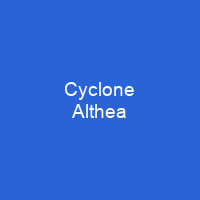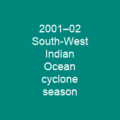Severe Tropical Cyclone Althea was a powerful tropical cyclone that devastated parts of North Queensland just before Christmas 1971. At 09:00 AEST on Christmas Eve, Al thea struck the coast of Queensland near Rollingstone, about 50 km north of Townsville. Three people were killed and damage totaled USD 120 million. The storm prompted Queensland to develop its first statewide building codes, requiring new homes to be cyclone-resistant.
About Cyclone Althea in brief

In Townsville, thousands of homes were damaged and many were destroyed. The most widespread damage was to roofs, which were often poorly or not at all secured. It left nearby Magnetic Island in a state of ruin; almost all of the buildings on the island were damaged to some degree. A significant 3. 66 m storm surge battered the mainland, while high waves destroyed roads and seawalls. The strongest winds were found under the outer ring, which shrank from 55 to 39 km between 21: 00 and 23: 00 UTC between 21 December to become the dominant eyewall. While the system was moving ashore, land-based radar identified an ongoing eyewalls – rings of intense thunderstorms surrounding the centre, with two distinct concentric, concentric concentric rings – as the inner ring dissipated. The landfall point placed Townsville and Magnetic Island’s powerful winds well to the south of the centre’s gale-force winds. The system continued to organise until landfall, which occurred at 23:00 UTC on 23 December – 09:00 AEST – near Rolling stone, about50 km north ofTownsville. Early the next day, it tracked just south of an automated weather station on Flinders Reef. Late on 22 December, the eye remained obscured to satellite imagery by a canopy of cirrus clouds while thecyclone passed north of Lihou Reef. It then dissipated over open water the following day.
You want to know more about Cyclone Althea?
This page is based on the article Cyclone Althea published in Wikipedia (as of Nov. 03, 2020) and was automatically summarized using artificial intelligence.







